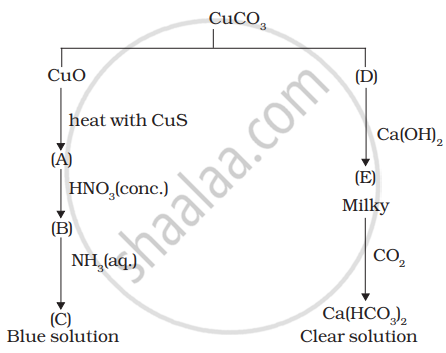Advertisements
Advertisements
प्रश्न
Identify A to E and also explain the reactions involved.

उत्तर
A = \[\ce{Cu}\]
B = \[\ce{Cu(NO3)2}\]
C = \[\ce{[Cu(NH3)4]}\]
D = \[\ce{CO2}\]
E = \[\ce{CaCO3}\]
F = \[\ce{Cu2[Fe(CN)6]}\]
G = \[\ce{Ca (HCO3)2}\]
\[\ce{CuCO3 -> CuO + CO2}\]
\[\ce{CuO + CuS -> \underset{(A)}{Cu} + SO2}\]
\[\ce{Cu + 4HNO3 (Conc) -> Cu \underset{(B)}{(NO3)2} + 2NO + 2H2O}\]
\[\ce{\underset{(B)}{Cu^2+} + NH3 -> \underset{(C)}{[Cu(NH3)4]}}\]
\[\ce{Ca(OH)2 + \underset{(D)}{CO2} -> \underset{(E)}{CaCO3} + H2O}\]
\[\ce{CaCO3 + CO2 + H2O -> Ca(HCO3)2}\]
APPEARS IN
संबंधित प्रश्न
What are interstitial compounds?
Describe the oxidising action of potassium dichromate and write the ionic equation for its reaction with iodide.
Read the passage given below and answer the following question:
The transition metals when exposed to oxygen at low and intermediate temperatures form thin, protective oxide films of up to some thousands of Angstroms in thickness. Transition metal oxides lie between the extremes of ionic and covalent binary compounds formed by elements from the left or right side of the periodic table. They range from metallic to semiconducting and deviate by both large and small degrees from stoichiometry. Since electron bonding levels are involved, the cations exist in various valence states and hence give rise to a large number of oxides. The crystal structures are often classified by considering a cubic or hexagonal close-packed lattice of one set of ions with the other set of ions filling the octahedral or tetrahedral interstices. The actual oxide structures, however, generally show departures from such regular arrays due in part to distortions caused by packing of ions of different size and to ligand field effects. These distortions depend not only on the number of d-electrons but also on the valence and the position of the transition metal in a period or group.
In the following questions, a statement of assertion followed by a statement of reason is given. Choose the correct answer out of the following choices on the basis of the above passage.
Assertion: Cations of transition elements occur in various valence states.
Reason: Large number of oxides of transition elements are possible.
When acidified \[\ce{K2Cr2O7}\] solution is added to \[\ce{Sn^{2+}}\] salts then \[\ce{Sn^{2+}}\] changes to ______.
When a brown compound of manganese (A) is treated with \[\ce{HCl}\] it gives a gas (B). The gas taken in excess, reacts with \[\ce{NH3}\] to give an explosive compound (C). Identify compounds A, B and C.
While filling up of electrons in the atomic orbitals, the 4s orbital is filled before the 3d orbital but reverse happens during the ionisation of the atom. Explain why?
Assertion: \[\ce{Cu}\] cannot liberate hydrogen from acids.
Reason: Because it has positive electrode potential.
Transition metals can act as catalysts because these can change their oxidation state. How does \[\ce{Fe(III)}\] catalyse the reaction between iodide and persulphate ions?
Photographic film and plates have - au essential ingredient of
Compare the general characteristics of the first series of the transition metals with those of the second and third series metals in the respective vertical columns. Give special emphasis on the following point:
Oxidation states
